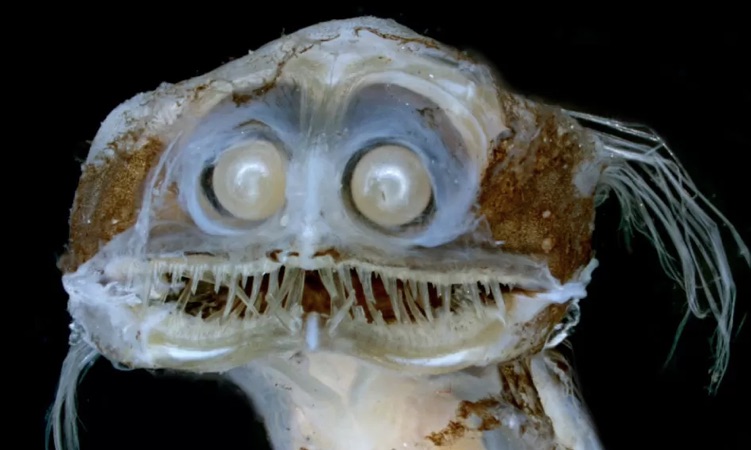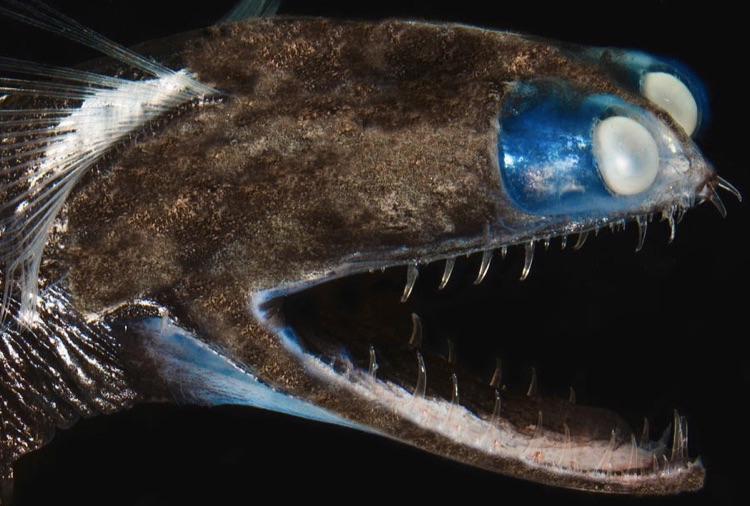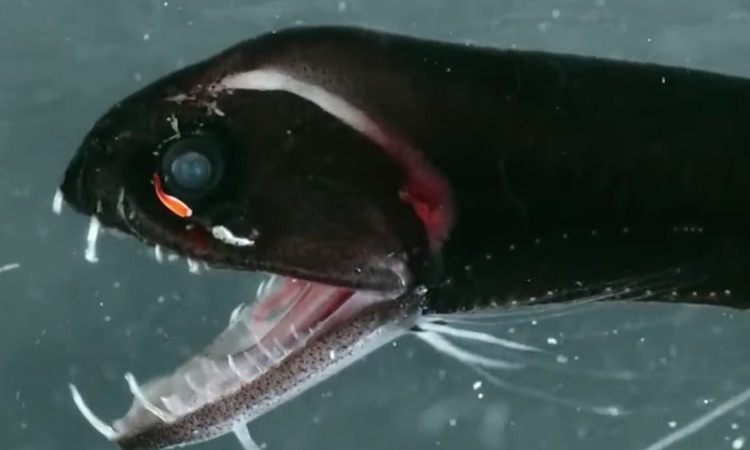The telescope fish is a unique, brightly colored fish that can be found in deep-sea tropical and subtropical waters. It lives three-quarter miles to 1.3 miles beneath the surface.
These fish dwell in the deep, far from natural light and away from the surface. To make up for it, Mother Nature endowed the telescope fish with tubular eyes that protrude from the head like binoculars. Read on to learn more.

Deep Sea Telescope Fish
The fish has adapted its eyes to see and seek prey in the most mesopelagic twilight zones of the ocean. The fish employs its distinct eyes to find food.
They swim, directing the attention upward to surfaces. They may discern silhouettes of their prey this way. The fish move vertically in the water column to observe both food and predator.
Size
The typical length of a telescope fish is between two and four inches. However, it can grow up to half a foot long in rare cases. A single case has been documented where a specimen reached 16 inches in length.
Nomenclature
The telescope fish is a deep-sea aulopiform species of fish named Gigantura chuni. There are only two species in the world.
Outside of that, little is known about the creatures. The genus name (Gigantura) is taken from Greek mythology’s Gigantes, a legendary group of giants.
The “oura” suffix means “end” or “tail,” and the word is a reference to the ribbon-like, elongated lower tailfin that makes up half of the fish’s total length.

Species of Telescope Fish
We do not know much about the telescope fish, but we do know that there are two species.
Gigantura Chuni
The Gigantura chuni, is a deep-sea creature that may be found in the Indian, Atlantic, and Pacific oceans. It also inhabits the Gulf of Mexico. In recent years, there have been sightings in South Africa as well. It has been observed in the seas of New Zealand, Chile, Saint Paul, Tasmania, and Gough Island.
Gigantura Indica
The Gigantura indica is a deep-sea creature with a silvery, scaleless body and tubular, forward-pointing eyes with large lenses and a ribbon-like tail. The animal’s eyes are similar to those of its cousin, the Gigantura chuni, which have tubular, ahead-directed eyes with big lenses.
Both species are adapted to specific water depths and environments. This is why experts do not believe the species suitable for captivity. This fish is superior in temperate seas, thus making difficult to adapt to tanks.
The overall cost of maintaining and protecting an environment for the telescope fish, as well as the expense of the animal itself, is prohibitively high.
Telescope Fish Appearance
The eyes of aequidens are extremely large, protruding, and have delicate glass screens. The bubbles lenses include around two dozen dorsal spines. From the correct perspective, they appear to be binoculars or more precisely, a pair of telescopes.
Telescope fish have big heads and a greenish-blue color with a silvery underside. The fish have blue dotting and tiny brown lines that form stripes along the sides and back. The fish have gritty, slimy scales and a pointy nose. The tail accounts for almost half of the fish’s total length.

Habitat
The telescope fish is found in tropical and subtropical waters all over world. Some countries territorial waters where they are most prevalent include New Zealand, Tasmania and Chile.
The population, which is not closely watched, is considered robust and of “Least Concern” by conservation organizations.
In several situations, such as the IUCN, the fish are not evaluated at all. There isn’t enough information about the numbers to generate trustworthy statistics because there aren’t enough records on them.
The fish’s range includes sub-Antarctic bodies of temperate cool seas with a habitat that ranges across the world’s oceans.
The telescopic scope is positioned more than 66 feet underwater in the water columns and up to 2,000 miles beneath the ocean floors. They may also be found in surge channels and vast low tide pools.
The telescope fish is a solitary by nature, but it will travel in groups. You’ll never see one its own. Grouping together makes for simpler hunting. It’s also a great way for the animals to keep an eye out for predators while everyone else is sleeping.
Predators and Prey
The telescope fish, like all other living animals, has its enemies and favorite foods. Let’s look at both of them now.
Predators
Due to their diminutive size, telescope fish are prey for larger carnivorous fish and sharks that dwell in these habitats.
Prey
This species is an active predator that can’t wait to get its teeth on bristlemouths, lanternfish, and barbed dragonfish. Like the sucker fish, they’ll also go after plankton.
The telescope fish engulfs its prey whole. Sea creatures that are frequently larger than it are among the victims. However, such a technique of consuming is typical for animals at those depths.
It has a long, flexible jaw with razor-sharp teeth. They capture food quickly, usually from below, whilst constantly looking upwards from the ocean floor.
Reproduction and Lifespan
There isn’t much to say about how they reproduce. However, we know that each species produces eggs only during a specific season of the year. The telescope fish is no exception. They lay eggs and wait for them to hatch.
Sea plants play host to the eggs. The species’ sexual habits, as well as the length of time it takes for them to hatch, remain unknown.
It lives between six and 25 years. This is a large age range because little research has been conducted on the fish to date.

Fishing and Cooking
They are difficult to catch because of how deep down in the ocean they live. As a result, they’re unlikely not appear on any restaurant menu.
Fun Facts
- Little is actually known about their dispersion, longevity, form, diet, and other factors.
- Gestures, tremors, motions, and body language are all forms of communication.
- Telescope fish have an extensible mouth and jaw, which comes in handy when eating food.
- Unlike many ocean creatures, there are no names for the fish genders.
- This species swims in syncronisation.




That’s really one ugly fish!
I think it’s cute in its own way.